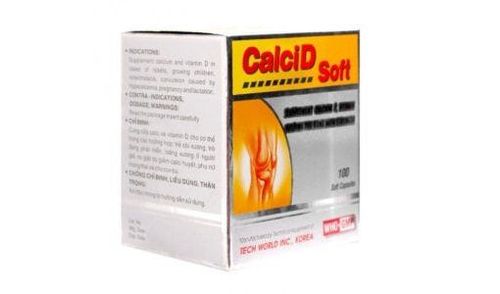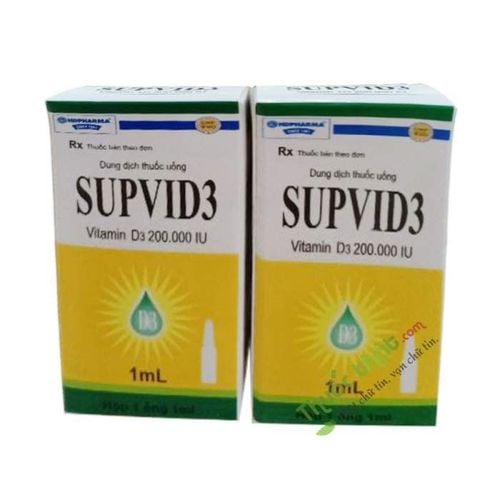This is an automatically translated article.
Calcium and vitamin D supplements are essential in some specific cases. One of the products that supplement these two micronutrients is Calcid. However, patients need to pay attention to some issues during the use of this product to limit unwanted side effects.
1. What is Calcid drug?
Calcid drug has the main ingredients calcium carbonate: 518mg, Vitamin D3: 100IU and excipients just enough for 1 tablet including: Lecithin, Beewax, Palm oil, Soybean oil.
Calcium is one of the minerals necessary for the development and maintenance of normal functions of the human body, especially the use of calcium is extremely important for the skeletal system, cardiovascular system, nervous system, etc. musculoskeletal system and affects the permeability of cell membranes.
Hypocalcemia can cause seizures, behavioral and personality disorders, growth retardation, mental retardation, bone deformities, rickets in children, osteomalacia in adults... Therefore, calcium supplementation is an essential part of the prevention and treatment of calcium deficiency. Vitamin D is a fat-soluble vitamin that helps maintain normal plasma calcium and phosphorus concentrations, increases the absorption of minerals from the diet, the small intestine, and increases the mobilization of calcium and phosphorus from the bones into the blood. Vitamin D deficiency will lead to hypocalcemia, hypophosphatemia, bone demineralization leading to bone pain, fracture, bone deformity, especially long bone deformity in children.
2. Uses of the drug Calcid
Calcid is a medicine to help supplement calcium and Vitamin D for the body in the following cases:
Children with rickets or in the stage of body development; Support the treatment of osteoporosis in the elderly; Indicated in convulsions due to hypocalcemia; Women who are pregnant or breastfeeding.

Thuốc Calcid là thuốc giúp bổ sung canxi và Vitamin D cho cơ thể
3. The process of absorption and metabolism of Calcid drugs after entering the body
Approximately one-third of calcium ingested is absorbed through the intestines and the extent of absorption may vary due to diet or function of the small intestine. The ability to absorb calcium will increase when the body's needs increase such as: calcium deficiency, growing children, pregnant women, nursing mothers...
Calcium absorption will decrease significantly with age. At the same time, diseases such as steatorrhea, diarrhea, chronic intestinal malabsorption syndrome also increase calcium excretion through feces. Under normal conditions, calcium is excreted mainly in the urine, a significant amount is excreted in milk during lactation and a small amount is excreted in sweat and feces. Another ingredient in calcid medicine is vitamin D, which is quite well absorbed from the gastrointestinal tract when the diet is low in fat and poorly absorbed when the meal is completely fat-free. About 80% of Vitamin D is concentrated in the chyme, so it is mainly absorbed by the lymphatic system. This vitamin is metabolized in the liver and kidneys to form derivatives that bind to proteins and circulate in the blood. In terms of elimination, Vitamin D and its metabolites are excreted mainly in the bile and feces, to a small extent in the urine or into breast milk.
4. Dosage and how to use Calcid
Calcid is used orally at a dose of 1-2 tablets/day for adults. Children should use this medicine under the prescription of a doctor. Note that the above dose is for reference only, the specific dose of calcid drug depends on factors such as condition or disease severity. Therefore, to get the right dose, the patient should consult a doctor or medical professional.
Vitamin D, if used in high doses and for a long time, can lead to hypervitaminosis D and calcium toxicity. Cases of overdose of Vitamin D should immediately stop the drug, stop taking supplements and maintain a calcium diet, infusion or drink plenty of water. If necessary, corticosteroids or some other drugs, especially diuretics that increase calcium excretion (such as loop diuretics furosemide and ethacrynic acid) can be used to reduce blood calcium levels. Sometimes cases of blood calcium poisoning need to undergo dialysis or peritoneal dialysis to remove free calcium from the body.
If vitamin D poisoning is acute (the patient has just used it), the absorption of Vitamin D can be prevented by measures to induce vomiting or gastric lavage. If the drug has been taken for a long time and the drug has passed through the stomach, the use of mineral oil can promote the elimination of Vitamin D in the stool.

Thuốc calcid sử dụng qua đường uống với liều lượng 1-2 viên/ngày cho người lớn
5. Side effects of the drug Calcid
The use of vitamin D supplements such as calcide at doses not exceeding physiological needs is not usually toxic. However, hypervitaminosis D may occur with high doses, prolonged use, or due to an increased response to usual doses of Vitamin D, the end result being manifestations of metabolic disorders. Calcium. In adults, hypervitaminosis D may be related to overdosage of Vitamin D with hypoparathyroidism or to high doses of Vitamin D. This side effect can occur in young children when the wrong dose of adult Vitamin D is taken. Initial signs and symptoms of Vitamin D toxicity are signs and symptoms of hypercalcemia, including:
Neurological manifestations such as weakness in limbs, fatigue, somnolence, headache; Gastrointestinal: Dry mouth, metallic taste, loss of appetite, nausea, vomiting, flatulence, constipation or diarrhea; Dizziness, ataxia, tinnitus, decreased muscle tone or pain, bone pain and irritability; Decreased sexual ability, calcium infection causing kidney dysfunction; Runny nose, itchy skin, osteoporosis in adults, decreased muscle growth in children; Weight loss, anemia; Hypertension, arrhythmia; Increased urinary calcium, phosphate, albuminuria, urea and serum cholesterol, liver enzymes AST and ALT. Decrease in serum alkaline phosphatase; Electrolyte disturbances with mild acidosis. The remaining ingredient in the drug calcid is Calcium carbonate which can cause some side effects such as:
Constipation; Flatulence; When taking high doses for a long time can cause increased gastric secretion and increased acid reflux; Hypercalcemia, especially in patients with renal failure or when taking high doses; Alkalosis may occur with an increase in plasma carbonate; Rarely cause alkalization of milk.
6. Some notes when using Calcid
Calcid is contraindicated for use in the following cases:
History of hypersensitivity or allergy to the components of the drug; Diseases associated with the syndrome of hypercalcemia or urine, calcium stones; Severe kidney failure. Some other cases need to be cautious when using calcid drugs:
Do not use at the same time with other drugs containing calcium and Vitamin D3; Use caution when administering Vitamin D to patients with renal insufficiency or nephrolithiasis, heart disease or atherosclerosis, who may be hypersensitive to Vitamin D (such as infants, sarcoidosis, hypothyroidism or parathyroid diseases). . For women who are pregnant, the use of calcium supplements is usually not harmful when taken in the correct dose. Hypercalcemia during pregnancy can lead to congenital disorders, hypoparathyroidism or neonatal parathyroid diseases, so pregnant women should not take higher doses of vitamin D. recommended (400 IU/day).
Calcium supplements are considered safe for breastfeeding women as long as the recommended daily dose is taken. Besides, Vitamin D can be excreted in breast milk, so women who are breastfeeding need to supplement Vitamin D according to the dose prescribed by the doctor (400IU/day).

Yếu tay chân, mệt mỏi là dấu hiệu và triệu chứng của tăng canxi máu
7. Drug interactions of the drug calcid
The drug calcid includes 2 components, calcium carbonate and vitamin D. Therefore, drug interactions will include interactions of vitamin D and calcium carbonate.
With interactions when using Vitamin D, users should note the following issues:
Cholestyramine, colestipol or hydrochloride cause reduced absorption of Vitamin D in the intestine; Excessive use of mineral oil can interfere with the absorption of Vitamin D in the intestines; Thiazide diuretics when used in patients with hypoparathyroidism and taking Vitamin D can lead to hypercalcemia; Phenobarbital or Phenytoin may decrease plasma concentrations of 25-hydroxy ergocalciferol and 25-hydroxy-cholecalciferol and thereby increase the metabolism of Vitamin D and inactive substances; Corticosteroids interfere with the effects of vitamin D when taken together; Cardiac glycosides because their toxicity is enhanced by hypercalcemia and leads to arrhythmias. Some calcium carbonate interactions to be aware of include:
Calcium may increase the toxicity of Digitalis to the heart; Thiazides, Ciprofloxacin, Chlorthalidone or other anticonvulsants that inhibit renal calcium excretion; Calcium reduces the absorption of Tetracycline. To ensure the effectiveness during the use of Calcid, users need to carefully read the instructions before use or consult a doctor or pharmacist.
Follow Vinmec International General Hospital website to get more health, nutrition and beauty information to protect the health of yourself and your loved ones in your family.
Please dial HOTLINE for more information or register for an appointment HERE. Download MyVinmec app to make appointments faster and to manage your bookings easily.













